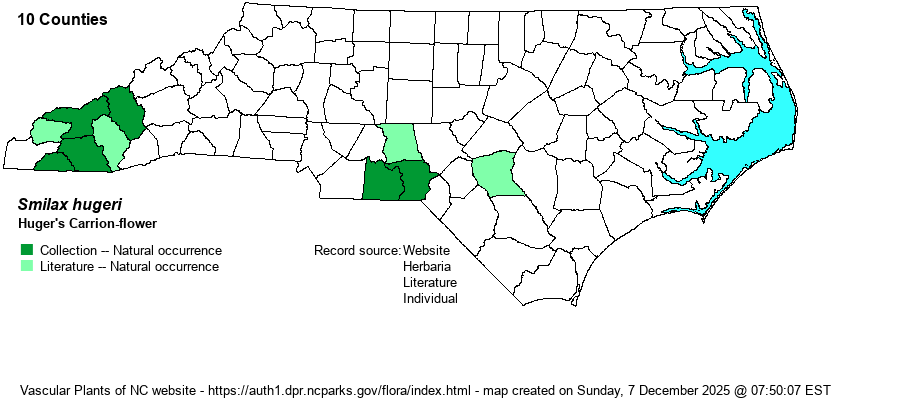| Author | (Small) J.B. Norton ex Pennell | |
| Distribution | A bimodal distribution – different varieties or species? – in the southern Mountains and in the southeastern Piedmont and adjacent Sandhills. Apparently no records yet between Haywood County on the west and Anson and Montgomery counties on the east. The range is still unsettled due to confusion with S. biltmoreana, with which both were included in the same species (though as separate varieties). The Haywood record (at USDA) is not supported by a specimen at SERNEC in 2022.
A Southern species ranging from NC and central TN south to northern FL and MS. The concentration of county records within that range is puzzling and needs further study.
| |
| Abundance | Rare to locally uncommon in the southern Mountains, and apparently very rare to rare in the southeastern Piedmont and adjacent Sandhills. This is an NC Significantly Rare species. | |
| Habitat | Unlike S. biltmoreana, this species favors rich, moist forests, and is seldom found on dry slopes and ridges. The Richmond County plants grew in a loamy sand soil inclusion within Longleaf Pine woodland. | |
| Phenology | Blooms in March and April, and fruits from August to October. | |
| Identification | This is an erect, deciduous herb that ranges to 1-2 feet tall, but often only 6-12 inches tall. Like S. biltmoreana, it has 5-7 leaves that are crowded near the top of the stem. However, S. hugeri has strongly pubescent leaves below, as opposed to glabrous in the other species. Huger’s Carrion-flower also differs in its nearly truncate or broadly rounded leaf bases, giving the leaves a more symmetrical shape. This species may also have more obvious serrations or scalloping along the leaf margins. The plants grow on moist, rich soils in forests as opposed to more dry slopes in Biltmore’s Carrion-flower. The odd NC range suggests that this species may be comprised of two species or two varieties; also, the fairly recent split of this species from S. ecirrhata also suggests that most biologists are not familiar with this species. | |
| Taxonomic Comments | Until recently, this taxon was one of three varieties included within S. ecirrhata (RAB 1968) and named as S. ecirrhata var. hugeri. This latter species has since been split into three species, with the nominate taxon (S. ecirrhata) found only west of NC.
| |
| Other Common Name(s) | None | |
| State Rank | S3 [S2S3] | |
| Global Rank | G4 | |
| State Status | SR-P | |
| US Status | | |
| USACE-agcp | | |
| USACE-emp | | |

